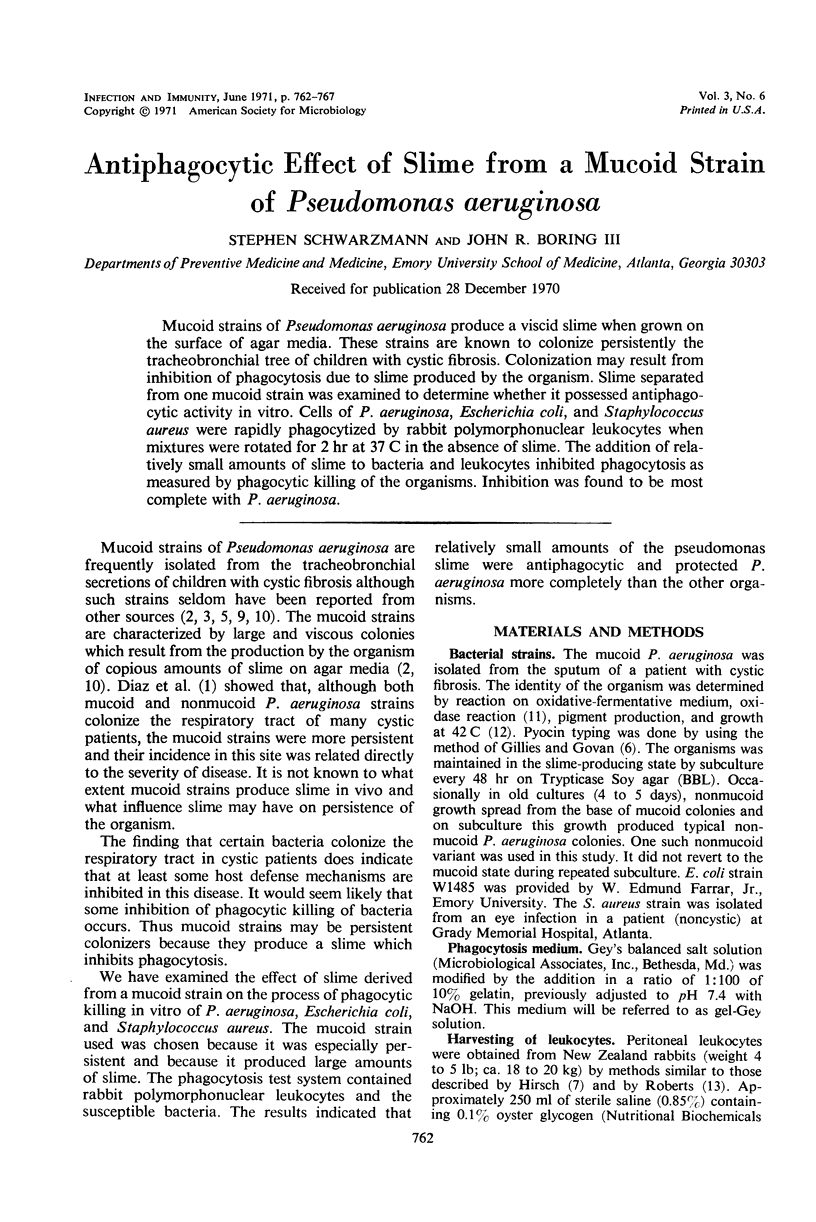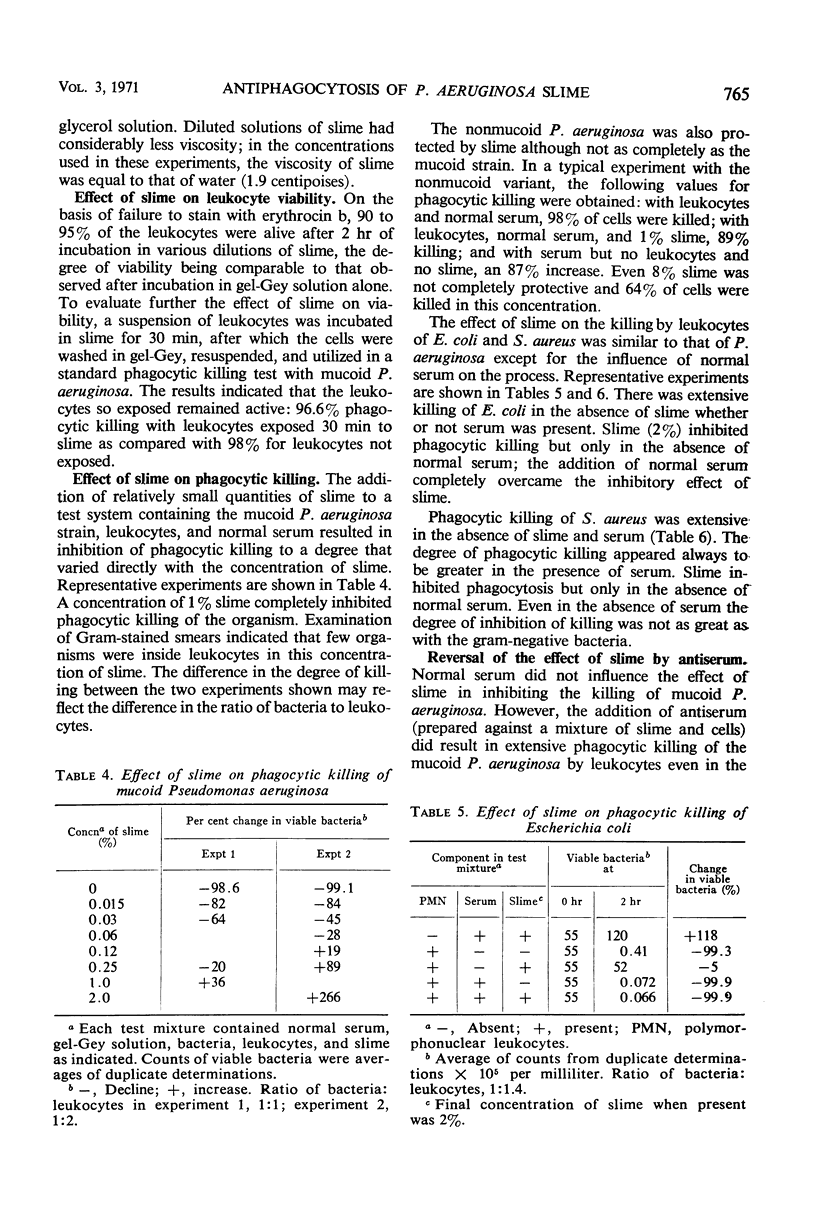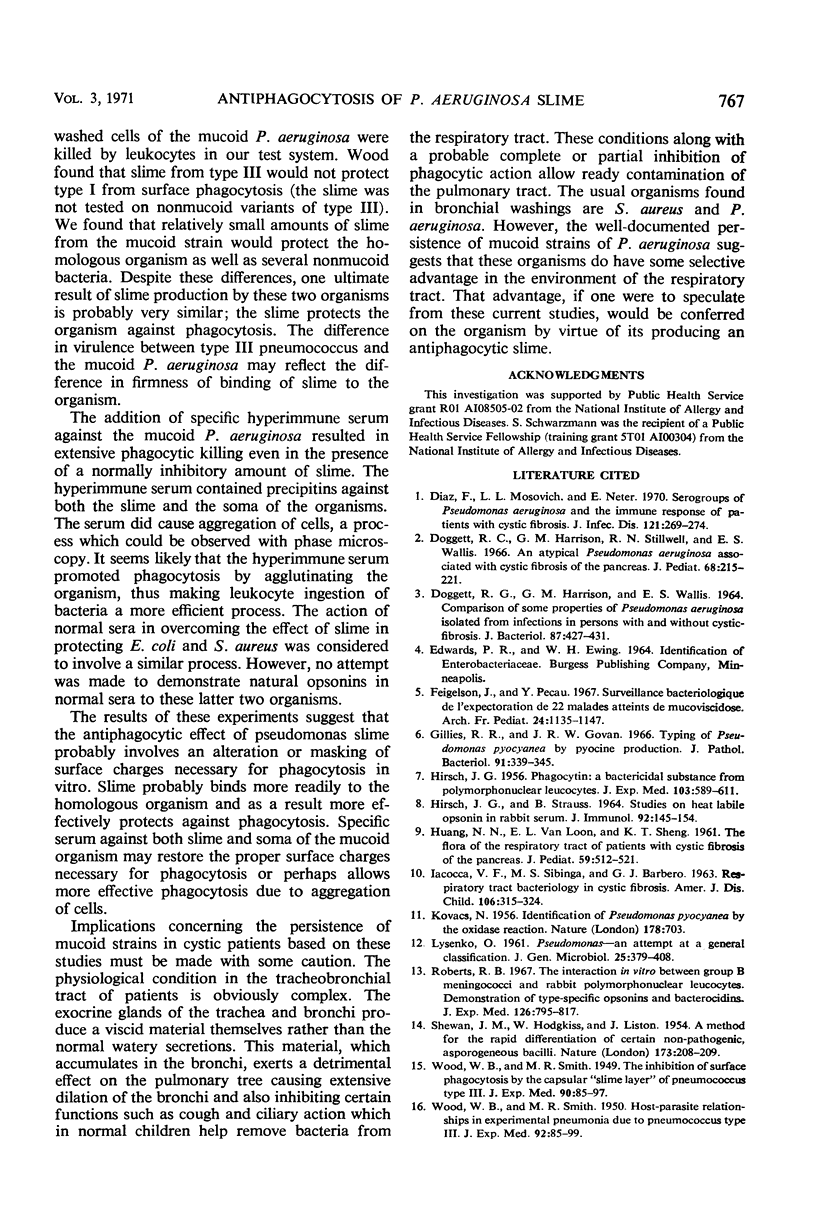Abstract
Mucoid strains of Pseudomonas aeruginosa produce a viscid slime when grown on the surface of agar media. These strains are known to colonize persistently the tracheobronchial tree of children with cystic fibrosis. Colonization may result from inhibition of phagocytosis due to slime produced by the organism. Slime separated from one mucoid strain was examined to determine whether it possessed antiphagocytic activity in vitro. Cells of P. aeruginosa, Escherichia coli, and Staphylococcus aureus were rapidly phagocytized by rabbit polymorphonuclear leukocytes when mixtures were rotated for 2 hr at 37 C in the absence of slime. The addition of relatively small amounts of slime to bacteria and leukocytes inhibited phagocytosis as measured by phagocytic killing of the organisms. Inhibition was found to be most complete with P. aeruginosa.
Full text
PDF





Selected References
These references are in PubMed. This may not be the complete list of references from this article.
- DOGGETT R. G., HARRISON G. M., WALLIS E. S. COMPARISON OF SOME PROPERTIES OF PSEUDOMONAS AERUGINOSA ISOLATED FROM INFECTIONS IN PERSONS WITH AND WITHOUT CYSTIC FIBROSIS. J Bacteriol. 1964 Feb;87:427–431. doi: 10.1128/jb.87.2.427-431.1964. [DOI] [PMC free article] [PubMed] [Google Scholar]
- Diaz E., Mosovich L. L., Neter E. Serogroups of Pseudomonas aeruginosa and the immune response of patients with cystic fibrosis. J Infect Dis. 1970 Mar;121(3):269–274. doi: 10.1093/infdis/121.3.269. [DOI] [PubMed] [Google Scholar]
- Feigelson J., Pecau Y. Surveillance bacteriologique de l'expectoration de 22 malades atteints de mucoviscidose. Arch Fr Pediatr. 1967 Dec;24(10):1135–1147. [PubMed] [Google Scholar]
- Gillies R. R., Govan J. R. Typing of Pseudomonas pyocyanea by pyocine production. J Pathol Bacteriol. 1966 Apr;91(2):339–345. doi: 10.1002/path.1700910207. [DOI] [PubMed] [Google Scholar]
- HIRSCH J. G. Phagocytin: a bactericidal substance from polymorphonuclear leucocytes. J Exp Med. 1956 May 1;103(5):589–611. doi: 10.1084/jem.103.5.589. [DOI] [PMC free article] [PubMed] [Google Scholar]
- HIRSCH J. G., STRAUSS B. STUDIES ON HEAT-LABILE OPSONIN IN RABBIT SERUM. J Immunol. 1964 Jan;92:145–154. [PubMed] [Google Scholar]
- HUANG N. N., VAN LOON E. L., SHENG K. T. The flora of the respiratory tract of patients with cystic fibrosis of the pancreas. J Pediatr. 1961 Oct;59:512–521. doi: 10.1016/s0022-3476(61)80234-5. [DOI] [PubMed] [Google Scholar]
- IACOCCA V. F., SIBINGA M., BARBERO G. J. RESPIRATORY TRACT BACTERIOLOGY IN CYSTIC FIBROSIS. Am J Dis Child. 1963 Sep;106:315–324. doi: 10.1001/archpedi.1963.02080050317012. [DOI] [PubMed] [Google Scholar]
- KOVACS N. Identification of Pseudomonas pyocyanea by the oxidase reaction. Nature. 1956 Sep 29;178(4535):703–703. doi: 10.1038/178703a0. [DOI] [PubMed] [Google Scholar]
- LYSENKO O. Pseudomonas--an attempt at a general classification. J Gen Microbiol. 1961 Jul;25:379–408. doi: 10.1099/00221287-25-3-379. [DOI] [PubMed] [Google Scholar]
- Roberts R. B. The interaction in vitro between group B meningococci and rabbit polymorphonuclear leukocytes. Demonstration of type specific opsonins and bactericidins. J Exp Med. 1967 Nov 1;126(5):795–818. doi: 10.1084/jem.126.5.795. [DOI] [PMC free article] [PubMed] [Google Scholar]
- SHEWAN J. M., HODGKISS W. A method for the rapid differentiation of certain nonpathogenic, asporogenous bacilli. Nature. 1954 Jan 30;173(4396):208–209. doi: 10.1038/173208b0. [DOI] [PubMed] [Google Scholar]
- WOOD W. B., SMITH M. R. Host-parasite relationships in experimental pneumonia due to pneumococcus type III. J Exp Med. 1950 Jul 1;92(1):85–100. doi: 10.1084/jem.92.1.85. [DOI] [PMC free article] [PubMed] [Google Scholar]


